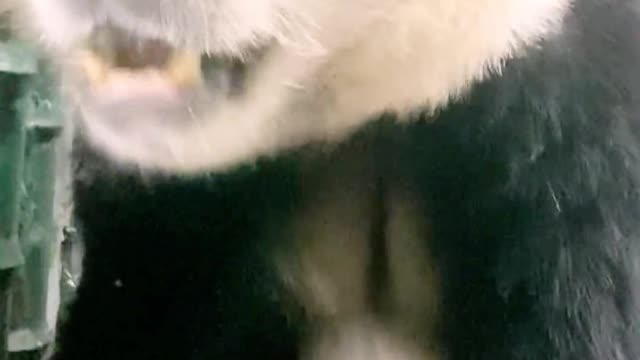Premium Only Content

The action of eating bamboo is too skilled
Giant panda (scientific name: Ailuropoda melanoleuca): it belongs to the carnivore, Ursidae, Giant Panda subfamily, and the only mammal of Giant Panda. There are only two subspecies. The male is slightly larger than the female. The body is plump, like a bear, with a round head and a short tail, 1.2-1.8m long head and 10-12cm long tail. Weighing 80-120 kg, the heaviest weight can reach 180 kg. The body color is black and white, the cheeks are round, there are large black circles under the eyes, the iconic walking style of the inside figure, and the sharp claws like a scalpel. The skin of giant pandas is thick, and the thickest part can reach 10mm. The black and white appearance is conducive to hiding on the trees in dense forests and on the snow covered ground without being easily discovered by natural enemies.
It lives in the dense bamboo forest at 2600-3500 meters above sea level, where the air is thin all the year round, surrounded by clouds, and the temperature is lower than 20 ℃. There are plenty of bamboos, and the distribution of terrain and water sources is conducive to the nesting and breeding of the species. Giant pandas are good at climbing trees and playing. The behavior of climbing trees is generally a way for the weak to avoid the strong when approaching the proposal period, or avoiding danger, or when meeting each other. Half of the time for giant pandas to eat is removed every day, and most of the remaining half of the time is spent in sleep. In the wild, giant pandas sleep for 2-4 hours between meals. 99% of the food of giant pandas is bamboo. There are 12 genera and more than 60 kinds of bamboo plants available for giant pandas. The life span of wild giant pandas is 18-20 years, and can exceed 30 years in captivity.
Giant pandas have lived on the earth for at least 8 million years. They are known as "living fossils" and "China's national treasures", i.e. national animals. They are the image ambassadors of the World Wide Fund for Nature, and are the flagship species of biodiversity conservation in the world.
-
 19:15
19:15
Stephen Gardner
16 hours ago🟢YES! Trump did it! + Elon Musk DROPS BOMBSHELL on Democrat Party!
12.5K75 -
 1:06:17
1:06:17
Mike Rowe
18 hours agoThe Mastermind Behind THIS Radical Idea At WSU Tech | Sheree Utash #448 | The Way I Heard It
70.1K9 -
 LIVE
LIVE
I_Came_With_Fire_Podcast
11 hours agoAncient Egypt's Tech & the Secret Temples of Malta
306 watching -
 LIVE
LIVE
GritsGG
1 hour agoWin Streaking! Most Wins 3499+ 🧠
251 watching -
 DVR
DVR
Bannons War Room
6 months agoWarRoom Live
34.1M8K -
 LIVE
LIVE
ttvglamourx
1 hour agoPLAYING WITH VIEWERS !DISCORD
92 watching -
 LIVE
LIVE
VapinGamers
1 hour agoTools of the Trade - Of Thumbnails and Titles, What's Important? - !rumbot !music
95 watching -
![Mr & Mrs X - [DS] Trafficking Empire – How Epstein Built His Web of Wealth and Deceit:Part 1 - Ep 5](https://1a-1791.com/video/fww1/f0/s8/1/o/k/J/d/okJdz.0kob-small-Mr-and-Mrs-X-DS-Trafficking.jpg) 52:11
52:11
X22 Report
3 hours agoMr & Mrs X - [DS] Trafficking Empire – How Epstein Built His Web of Wealth and Deceit:Part 1 - Ep 5
70.1K13 -
 1:13:18
1:13:18
Wendy Bell Radio
7 hours agoPet Talk With The Pet Doc
42.4K61 -
 LIVE
LIVE
dieseldesigns
5 hours agoExploring Labs In the DARK! // Abiotic factor
29 watching